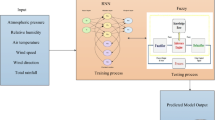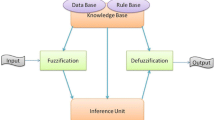Abstract
Air pollution is capable of affecting human beings seriously, even leading to death, by damaging important organs. The air pollution level is not unique in a country or even in a city due to the different circumstances. The world requires a strong air quality prediction system to predict air quality by analyzing the current trends of air quality using data collected from different cities in a country. For this purpose, a new neuro-fuzzy temporal and spatial constraint to be aware of air quality is proposed for predicting the air quality of a city or country in future. In this chapter, we propose a new classifier called the Neuro-Fuzzy Temporal Classification algorithm (NFTCA) with spatial constraints (NFTCA-S) for predicting the air quality of the city/country. Moreover, an effective feature optimization technique called Butterfly Optimization Algorithm (BOA) is also proposed for enhancing accuracy of air quality prediction. The PM2.5 dataset is used in this work to evaluate the proposed air quality prediction system. The dataset is collected from the UCI Machine Learning Repository and the NCPC; these websites maintain the air pollution status of various states. The dataset is used as input for the training and testing procedures as well as being split into training and testing datasets at a ratio of 80:20. Finally, the prediction system demonstrated its value by accurately predicting the concentrations of sulfur dioxide, carbon monoxide, and nitrogen oxides.
Access this chapter
Tax calculation will be finalised at checkout
Purchases are for personal use only
Similar content being viewed by others
References
Gu, K., Qiao, J., & Lin, W. (2018). Recurrent air quality predictor based on meteorology- and pollution-related factors. IEEE Transactions on Industrial Informatics, 14(9), 3946–3955.
Huang, Y., Zhao, Q., Zhou, Q., & Jiang, W. (2018). Air quality forecast monitoring and its impact on brain health based on big data and the internet of things. IEEE Access, 6, 78678–78688.
Huang, Y., Xiang, Y., Zhao, R., & Cheng, Z. (2020). Air quality prediction using improved PSO-BP neural network. IEEE Access, 8, 99346–99353.
Andò, B., Baglio, S., Graziani, S., & Pitrone, N. (2000). Models for air quality management and assessment. IEEE Transactions on Systems, Man, and Cybernetics—Part C: Applications and Reviews, 30(3), 358–363.
Ganapathy, S., Sethukkarasi, R., Yogesh, P., Vijayakumar, P., & Kannan, A. (2014). An intelligent temporal pattern classification system using fuzzy temporal rules and particle swarm optimization. Sadhana, 39(2), 283–302.
Kanimozhi, U., Ganapathy, S., Manjula, D., & Kannan, A. (2019). An intelligent risk prediction system for breast cancer using fuzzy temporal rules. National Academy Science Letters, 42(3), 227–232.
Huang, G., Zhao, G., He, G., & Wang, Q. (2019). Innovative spatial-temporal network modeling and analysis method of air quality. IEEE Access, 7, 26241–26254.
Chauhan, R., Kaur, H., & Alankar, B. (2021). Air quality forecast using convolutional neural network for sustainable development in urban environments. Sustainable Cities and Society, 75(103239), 103239.
Soh, P. -W., Chang, J. -W., & Huang, J. -W. (2018). Adaptive deep learning-based air quality prediction model using the most relevant spatial-temporal relations. IEEE Access, 6, 38186–38199.
Zhou, Y., Zhao, X., Lin, K.-P., Wang, C.-H., & Lie, L. (2019). A Gaussian process mixture model-based hard-cut iterative learning algorithm for air quality prediction. Applied Soft Computing, 85, 105789.
Zhang, Y., et al. (2019). A predictive data feature exploration-based air quality prediction approach. IEEE Access, 7, 30732–30743.
Ma, J., Cheng, J. C. P., Lin, C., Tan, Y., & Zhang, J. (2019). Improving air quality prediction accuracy at larger temporal resolutions using deep learning and transfer learning techniques. Atmospheric Environment, 214, 116885.
Schürholz, D., Kubler, S., & Zaslavsky, A. (2020). Artificial intelligence-enabled context-aware air quality prediction for smart cities. Journal of Cleaner Production, 271, 121941.
Ha, Q. P., Metia, S., & Phung, M. D. (2020). Sensing data fusion for enhanced indoor air quality monitoring. IEEE Sensors Journal, 20(8), 4430–4441.
Huang, W., Li, T., Liu, J., Xie, P., Du, S., & Teng, F. (2021). An overview of air quality analysis by big data techniques: Monitoring, forecasting, and traceability. Information Fusion, 75, 28–40.
Zheng, H., Cheng, Y., & Li, H. (2020). Investigation of model ensemble for fine-grained air quality prediction. China Communications, 17, 207–223.
Zhang, D., & Woo, S. S. (2020). Real time localized air quality monitoring and prediction through mobile and fixed IoT sensing network. IEEE Access, 8, 89584–89594.
Zhang, Y., Zhang, R., Ma, Q., Wang, Y., Wang, Q., Huang, Z., & Huang, L. (2020). A feature selection and multi-model fusion-based approach of predicting air quality. ISA Transactions, 100, 210–220.
Lin, Y.-C., Lee, S.-J., Ouyang, C.-S., & Wu, C.-H. (2020). Air quality prediction by neuro-fuzzy modeling approach. Applied Soft Computing, 86, 105898.
Xu, X., & Yoneda, M. (2021). Multi task air quality prediction based on LSTM autoencode model. IEEE Transactions on Cybernetics, 51(5), 2577–2586.
Chen, E., & Brauer, M. (2021). Traffic related air pollution and stress: Chen and Brauer respond. Environmental Health Perspectives, 116, 9.
Saravanan, D., & Santhosh Kumar, K. (2021). Improving air pollution detection accuracy and quality monitoring based on bidirectional RNN and the Internet of Things. Materials Today: Proceedings. https://doi.org/10.1016/j.matpr.2021.04.239.
Krishna Rani Samala, K., Babu, K. S., & Das, S. K. (2021). Temporal convolutional denoising autoencoder network for air pollution prediction with missing values. Urban Climate, 38, 100872.
Arora, S., & Singh, S. (2019). Butterfly optimization algorithm: A novel approach for global optimization. Soft Computing, 23(3), 715–734.
Zhang, W., & Wang, T. (2010). Model integration anthropogenic heat for improving air quality forecasts over Beijing City. IEEE Transactions in Pollution Environment, 25(4), 815–824.
Neagu, C.-D., Kalapanidas, E., Avouris, N., & Bumbaru, S. (2001). Air quality prediction using neuro-fuzzy tools. IFAC Proceedings, 34(8), 229–235.
Author information
Authors and Affiliations
Corresponding author
Editor information
Editors and Affiliations
Rights and permissions
Copyright information
© 2023 The Author(s), under exclusive license to Springer Nature Switzerland AG
About this chapter
Cite this chapter
Anu Priya, S., Khanaa, V. (2023). An Intelligent Air Quality Prediction System Using Neuro-Fuzzy Temporal Classifier with Spatial Constraints. In: Joseph, F.J.J., Balas, V.E., Rajest, S.S., Regin, R. (eds) Computational Intelligence for Clinical Diagnosis. EAI/Springer Innovations in Communication and Computing. Springer, Cham. https://doi.org/10.1007/978-3-031-23683-9_11
Download citation
DOI: https://doi.org/10.1007/978-3-031-23683-9_11
Published:
Publisher Name: Springer, Cham
Print ISBN: 978-3-031-23682-2
Online ISBN: 978-3-031-23683-9
eBook Packages: EngineeringEngineering (R0)




